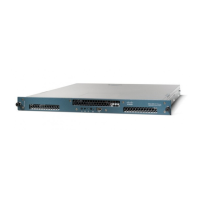1-21
Cisco 4700 Series Application Control Engine Appliance Administration Guide
OL-11157-01
Chapter 1 Setting Up the ACE
Synchronizing the ACE with an NTP Server
Viewing the System Clock Settings
To display the system clock of the ACE, use the show clock command in Exec
mode. The syntax of this command is as follows:
show clock
For example, to view the current cloc
k settings, enter:
host1/Admin# show clock
Sun Oct 7 07:43:02 UTC 2007
Synchronizing the ACE with an NTP Server
The Network Time Protocol (NTP) enables you to synchronize the ACE system
clock to a time server. NTP is an Internet protocol designed to synchronize the
clocks of computers over a network. Typically, an NTP network receives its time
from an authoritative time source, such as a radio clock or an atomic clock
attached to a time server, and assures accurate local time-keeping. NTP distributes
this time across the network. The NTP protocol can synchronize distributed
clocks within milliseconds over long time periods.
NTP runs over User Datagram Protocol (UDP), which runs over IP. NTP is
d
ocumented in RFC 1305. All NTP communication uses Coordinated Universal
Time (UTC), which is the same as Greenwich Mean Time.
An NTP server must be accessible by the client ACE.
Note If you are configuring application acceleration and optimization functionality (as
described in the Cisco 4700 Series Application Control Engine Appliance
Application Acceleration and Optimization Configuration Guide), and you plan
to use an optional Cisco AVS 3180A Management Console with multiple ACE
nodes, we strongly recommend that you synchronize the system clock of each
ACE node with an NTP server. AppScope performance monitoring relies on very
accurate time measurement, in the millisecond range. If you instal multiple ACE
appliances, you must synchronize the clocks so that different parts of a single
transaction can be handled by different nodes.

